A visit to the buried city
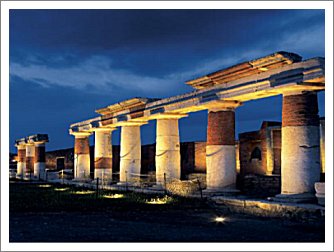
Pompeii
With roughly four fifths of its urban area excavated, Pompeii is the most famous and most evocative archaeological site in the world. The Roman centre that can be visited today is in fact descended from another older site, which was founded at the beginning of the 6th century BC by the Oscans, an Italic people succeeded by the Samnites. Numerous traces of the Italic city remain to this day. The eruption of Vesuvius in 79 AD buried the city under a blanket of ash and lapilli that was 6 to 7 metres thick. Most of the inhabitants of the city, having fled their homes, died on the seashore. The few who were left, in the vain hope of saving themselves in the underground passages beneath their houses, suffocated. The moulds of their dying bodies, which were obtained by pouring liquid chalk into the cavities left in the layer of ash by their bodies, are a moving illustration of the tragedy. Walking around the Pompeian excavations is a unique experience. It is reminiscent of a journey through time, and provides the opportunity to take in the atmosphere of public and especially private life in antique times. The most surprising aspect is the number of houses, both luxurious and humble, still preserved and complete with their workshops, inns and ovens.
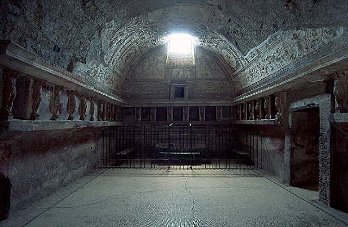
![]()
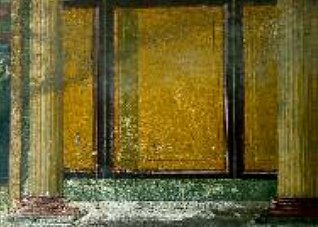
................................Pompeii: Thermae ......... Pompei: villa dei misteri- affreschi (particolare)
More impressive is the fact that many furnishings have remained intact, allowing us an insight into the more intimate side of this ancient people. In the summer, the Archaeological Board of Pompeii, in collaboration with the Campania Region and the Department of Cultural Heritage, organize night-time walks through the excavations. The tour takes in some of the most evocative parts of Pompeii by night, and features the music of Ennio Morricone. A multimedia show reconstructs the drama of the eruption. The Forum was the political, administrative and commercial centre of the city, a large rectangular square (38x142 metres) paved with travertine and enclosed on three sides by colonnades. The square is home to the Capitolium (the temple dedicated to Jupiter), the Temple of Apollo, built around the 3rd century BC and shaped by a portico with 48 Ionic columns, and the Basilica, the most important public building, which housed the Tribunal and was the centre of economic life. Also by the Forum are the Temple of Vespasian, which is dedicated to the imperial cult, the Granaries, where cereals were collected to be sold, and the Macellum, the covered market selling fresh produce, such as meat and fish, with ta-bernae (taverns) tucked inside.

Pompeii: villa of the Mysteries: frescoes (detail)
The Forum Thermae are nearby, too, and are divided into different sections for men and women, with central heating common to both. The most important artery of the city was Via dell’Abbondanza (a modern name, like all of those in Pompeii), which was home to craftsmen’s workshops, taverns, inns and dyers’ shops. The street is also home to the Stabian Thermae, the oldest building in Pompeii. Nearby is the famous brothel, a two-floor building whose function is betrayed by explicit and erotic wall paintings and writings. Of the houses, the House of the Faun is the most beautiful due to its architecture and its famous mosaics, such as the famous Alexander Mosaic, which depicts a battle between Alexander the Great and Darius III of Persia, a masterpiece now housed in the National Archaeological Museum of Naples. The House of the Vettii is famous for the splendid frescoes that adorn the walls.
.......... 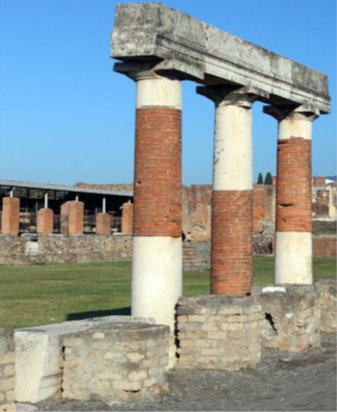
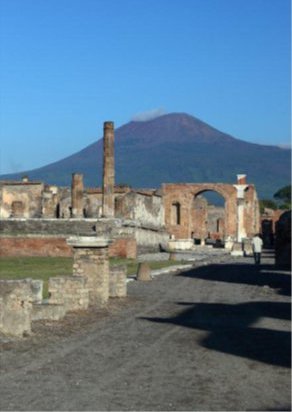
............................................................................Pompeii: excavations
The house belonged to two merchants, Aulus Vettius Conviva and Aulus Vettius Restitutus. The House of Menander, which takes its name from a painting depicting the Greek playwright, contained a very rich collection of silver furnishings of exceptional quality, which is now housed in the National Archaeological Museum of Naples. One of the most important buildings in Pompeii is the Villa of Mysteries, which is especially famous for its paintings. The most famous is the huge fresco which gives the house its name, and which features twenty-nine life-size figures depicted in vivid colours on a red background, perhaps an initiation scene to the cult of Dionysus or to the Orphic Mysteries. The Forum is contrasted by the theatre area, the epicentre of cultural and religious activities in Pompeii, built in the 2nd century BC.
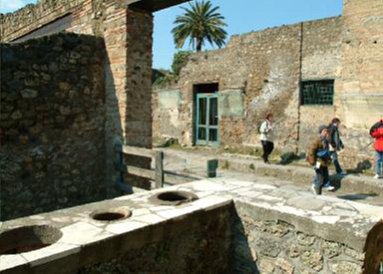
Pompeii: excavations
In the theatre quarter, the Grand Theatre, where shows were put on in summer, and the small Odeion, have been excavated. Close by is the beautiful Temple of Isis. An epigraph shows that the Amphitheatre is the oldest building of its kind known to us. Next to the Amphitheatre is the Great Palestra, which was built under Augustus and used for gymnastics. It is a vast square area surrounded by porticoes, with a central pool and diving board. A sunset visit to Via dei Sepolcri, a street flanked by funereal monuments that leads to Herculaneum, is particularly exciting. A visit to excavations at Pompeii takes at least a day. Today Pompeii is a modern town set up to host tourists, with hotels, campsites, restaurants, pizzerias, bars, pubs and shops. It is a cosmopolitan place, the destination for a significant number of tourists from Italy and abroad.
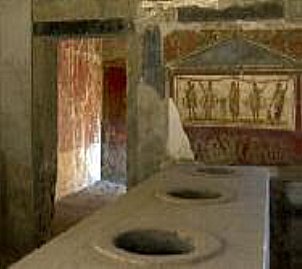
![]()
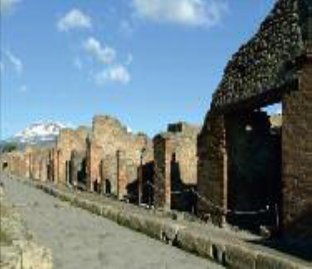
Pompei – inns ............... Pompeii: excavations
Many of the tourists who visit the town not only visit Pompeii, but use it as a base for excursions to the numerous tourist towns nearby, which are easily accessible both by private means and by public transport. Since the 1997 decree, Pompeii has featured in the UNESCO list of World Heritage Sites. Near Pompeii, in the area today known as Torre Annunziata, a villa perhaps belonging to Poppaea Sabina, second wife of the Emperor Nero, has been found. The discovery was made in Oplontis, in the old suburban quarter of Pompeii, which was destroyed by the eruption of 79 AD. It is one of the grandest and best preserved examples of ‘otium’ villas (dating from the middle of the first century BC). After being partly abandoned at the time of the eruption, due to restoration works following the earthquake of 62 AD, the villa’s decoration and spectacular view meant that it had no reason to envy even imperial residences. The sculptures and frescoes in the villa are astonishing.
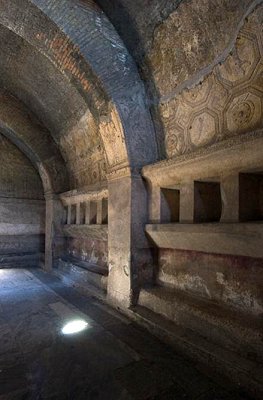
.Pompeii: Thermae